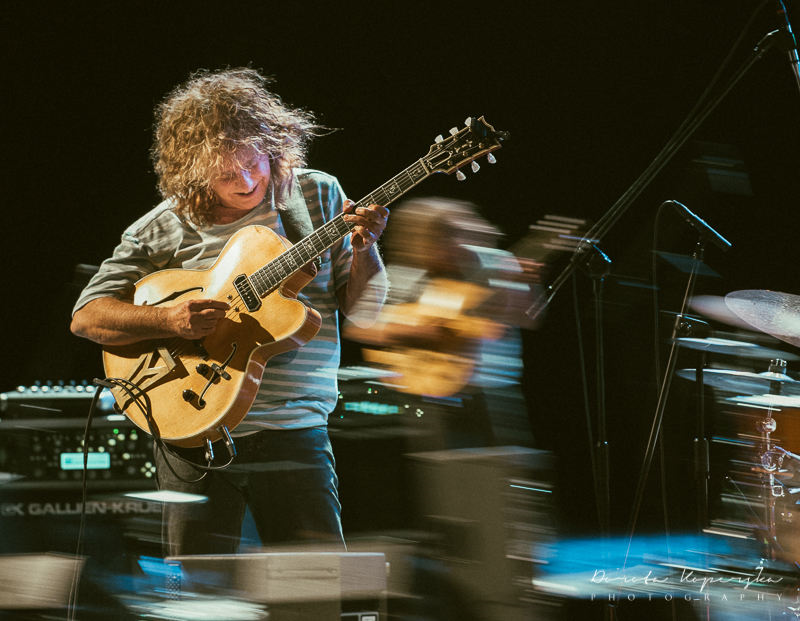Finding the Heartbeat of Human Creativity in the Brain
- Published15 Oct 2019
- Author Levi Gadye
- Source BrainFacts/SfN

Jazz guitarist Pat Metheny is famous for his exceptional skill with improvisation, but when he first got his hands on a guitar, at the age of 12, he didn’t really know what to do with it. Born into a family of trumpet players, Metheny had to learn the basics of guitar on his own.
“Within the first few days of getting a guitar, I couldn’t play an F chord,” which requires holding down two strings with one finger, Metheny recalled. “But I remember realizing, ‘Oh, if I don’t push down the two strings, I actually liked the way that sounds even more,’ which of course is an F major 7 chord, instead of an F. I had no idea of knowing that. That was my first moment of improvising.”
Musical improvisation — making up music on the spot — isn’t that different from “every single thing we all do, every day,” said the 20-time Grammy award winner. However, the jazz improvisation and musicianship that Metheny is known for allows musicians to wordlessly express stories and emotions — an area of interest for neuroscientists who want to understand the origins of creativity in the brain.
One of those neuroscientists is Charles Limb, professor of otolaryngology (ear, nose, and throat medicine) at UC San Francisco. Limb grew up immersed in music, like Metheny, but opted for a career in medicine as his way of “contributing to the world” after college. Fittingly, his chosen field allowed him to help people with their hearing.
As his medical career progressed, however, Limb maintained his passion for music by pioneering the study of improvisation and the brain.
“If you want to understand something as complicated as music, perception, performance, or emotion, whatever it might be, you may have to understand the ear and the process of hearing, but you also have to understand the brain,” said Limb.
Driven by this curiosity about how the brain enables improvisation, Limb designed a system that allowed musicians to play a plastic keyboard while strapped inside of an MRI machine. He recorded their brain activity while they played a memorized song, and then compared it to their brain activity during improvisation.
The experiment revealed that during improvisation, but not while playing memorized music, the brain of a trained expert decreases its activity in the prefrontal cortex, a region that’s “responsible for conscious self-monitoring and effortful planning,” said Limb. “You can view that as the brain surrendering … its conscious control during creative improvisation.”
Furthermore, the brain dedicated more of its resources to regions responsible for listening (temporal lobe) and for playing an instrument (sensorimotor cortex) during improvisation, “even though there was not more sound being heard, or more notes being played,” Limb explained. The results implied that the brain could be focusing more purely on the experience of making music when a musician is improvising, as opposed to consciously thinking through each successive note.
“That first jazz study was important for me because it showed that the way I was asking this question about creativity was [scientifically] reasonable,” he said. “It was a musically natural behavior, and we were able to approach it the same way you approach any other complicated biological activity. [It showed that creativity] doesn’t have to just remain in the realm of the mystical.”
In 2014, Limb followed up on this work by looking at how jazz musicians “trade fours,” or swap short, improvised solos that build off of one another, and discovered that this type of improvisation depends on areas of the brain that are responsible for language production and comprehension, such as Broca’s and Wernicke’s areas.
That sort of finding is quite familiar to Metheny, whose decades of experience playing jazz with hundreds of musicians have given him a keen sense of the purpose of improvisation: communication and connection.
“Improvisation manifests itself like storytelling to me,” said Metheny. “There’s a strong correlation to a narrative, in a positional way of presenting information, of taking ideas, following them, letting them run their course. This connection between improvisation and everyday life grows and grows as the years go by, and as my fluency as an improvising musician has increased.”
![]()
Although Metheny tours the world with his guitar while Limb works with hearing-loss patients, ultimately their interests intersect at the heart of what it means to be human.
Limb is now pursuing an even more ambitious project: An investigation, funded by the National Endowment for the Arts, of the brain activity of “transformative artists who have really defined the way we hear music and the way we see the world,” said Limb. By “literally peering into the minds of creative geniuses,” on an individual basis, Limb hopes to illuminate broader truths about human creativity — and potentially identify ways to boost that creativity.
“There’s maybe nothing more important to understand than how humans create new ideas,” said Limb, “because this is how we evolve and survive and advance as a society.”
CONTENT PROVIDED BY
BrainFacts/SfN
Discussion Questions
- Why are neuroscientists interested in studying jazz improvisation?
- How do neuroscientists study improvisation in the lab?
- What are neuroscientists and musicians hoping to learn about the brain in the future?
References
Donnay, G. F., Rankin, S. K., Lopez-Gonzalez, M., Jiradejvong, P., & Limb, C. J. (2014). Neural Substrates of Interactive Musical Improvisation: An fMRI Study of ‘Trading Fours’ in Jazz. PLOS ONE, 9(2), e88665. doi: 10.1371/journal.pone.0088665
Limb, C. J., & Braun, A. R. (2008). Neural Substrates of Spontaneous Musical Performance: An fMRI Study of Jazz Improvisation. PLOS ONE, 3(2), e1679. doi: 10.1371/journal.pone.0001679
Also In The Arts & The Brain
Trending
Popular articles on BrainFacts.org



















